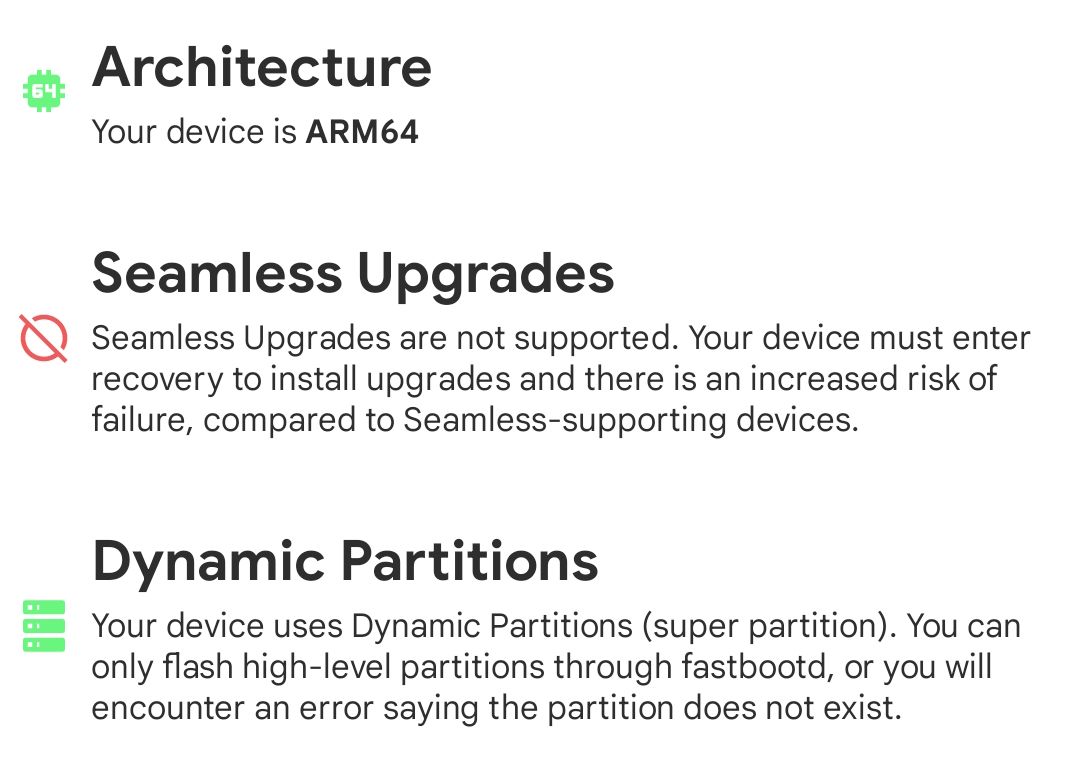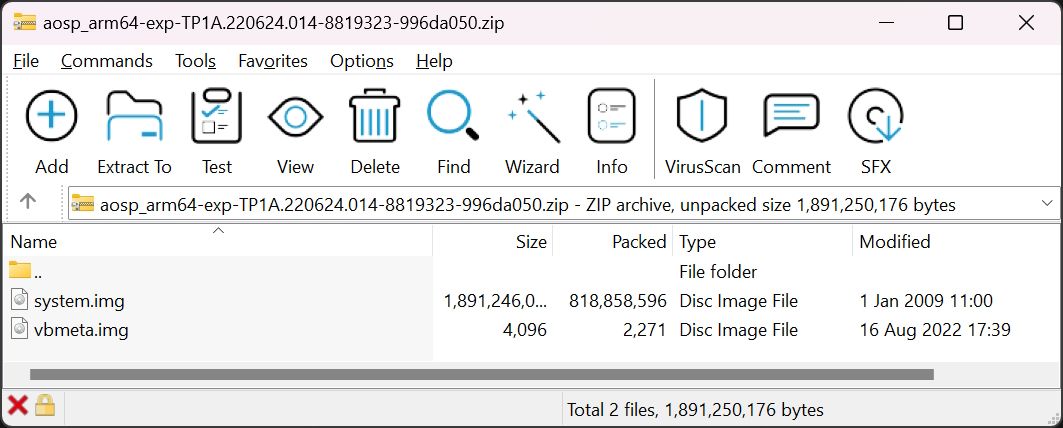In 2017, Google’s Challenge Treble was launched, bringing a considerable architectural change to Android. Particularly, it separated the Android working system, which is similar for all units, from the low-level software program that’s particular to every gadget. Because of this, Android smartphone producers (OEMs) and customized ROM builders can now course of Android upgrades sooner than earlier than, on units operating Android 9 and above.
Challenge Treble additionally gave start to GSIs. A GSI (Generic System Picture) encompasses a pure Android implementation and comprises adjusted configurations to make it work on any Challenge-Treble-compliant gadget. With a GSI, you’ll be able to expertise a brand new Android model earlier than your OEM releases the over-the-air improve in your cellphone.
Right here, we’ll information you on flashing a GSI on supported Android units.
Conditions Earlier than Flashing a GSI
Flashing a Generic System Picture on an Android gadget is a straightforward course of. Besides, there are a couple of factors to test earlier than beginning. These stipulations will assure you’ve a easy expertise, so do not skip any of them:
As soon as every little thing is in test, you’ll be able to proceed with the Android GSI set up beneath.
Step 1: Guarantee Your System Helps Challenge Treble
Earlier than you do anything, double-check that your Android gadget is Trebalized (Challenge Treble suitable). Google has made it a basic rule of thumb that each gadget launching with Android 8 (Oreo) or later ships with Challenge Treble compatibility, however there isn’t a hurt in confirming this in your gadget.
A easy means to do that is by downloading the Treble Information app from the Google Play Retailer. Launch the app, head over to the Treble and VNDK part, and when you see a inexperienced tick on the left, your Android gadget helps Challenge Treble. The abstract gives extra data, together with the VNDK (Vendor Native Improvement Equipment) veion quantity comparable to your gadget’s Android model.
Step 2: Affirm the CPU Structure and Partition Information
Android GSIs goal a number of CPU architectures, together with ARM, ARM64, x86, and x86-64. As such, be sure to receive the right GSI in your gadget’s CPU. To search out your gadget’s CPU structure, open the Treble Information app once more. You may discover the gadget’s CPU variant underneath the Structure part.
Earlier than closing the app, underneath the Dynamic Partitions part, test whether or not your gadget makes use of dynamic partitions. You may want this data to find out whether or not to flash the GSI in fastboot or fastbootd mode later.
Fastboot or Fastbootd mode is accessible when the Android OS is not operating and helps you learn or write to your cellphone’s flash reminiscence. Train excessive warning when utilizing any of those modes.
Step 3: Obtain a GSI
Now that you recognize your gadget’s CPU structure data, head to Google’s GSI releases web page in your PC to search out an applicable GSI. Keep in mind to obtain a GSI that matches your Android model or larger.
If you need a GSI with Google Play Companies, select the one with gms within the file identify. After a profitable obtain, you will discover system.img and vbmeta.img recordsdata within the GSI zip folder.
Now, extract the system.img and vbmeta.img recordsdata and place them within the Platform Instruments folder you arrange within the stipulations part above. Putting these recordsdata in the identical folder because the Platform Instruments ensures that each one the instructions beneath will run efficiently.
Step 4: Boot Into Fastboot or Fastbootd Mode
Earlier than operating any instructions, you could join your Android gadget to the Home windows PC and allow USB Debugging. After that, open a Command Immediate window within the Platform Instruments folder. A easy means to do that is to sort the phrase cmd within the folder’s handle bar and hit Enter on the keyboard.
Subsequent up, sort the next command within the ensuing command immediate window and hit Enter as well your Android gadget into Fastboot mode.
adb reboot bootloader In the event you discovered that your gadget helps Dynamic Partitions in Step 2 above, that you must run the next further command as well the Android gadget into Fastbootd mode. Failure to take action will lead to errors about lacking partitions once you attempt to set up the GSI. Skip this command in case your gadget would not have Dynamic Partitions.
fastboot reboot fastboot At this level, your gadget is now able to be flashed with the GSI recordsdata you extracted.
Step 5: Flash the Android GSI through Fastboot or Fastbootd
To keep away from points booting the GSI, you could disable AVB (Android Verified Boot) by executing the command beneath. OEMs use AVB to make sure the integrity and authenticity of the Android system operating in your smartphone. Skip this command in case your gadget would not ship with AVB. You may know this if the command throws out an error that the partition doesn’t exist in your gadget.
fastboot --disable-verity --disable-verification flash vbmeta vbmeta.img Subsequent up, erase the system partition to take away the at present put in Android OS utilizing the command beneath. Putting in the GSI over the prevailing Android system will lead to points like countless boot loops the place your gadget doesn’t end the boot course of, regardless of how lengthy you wait.
fastboot erase system Flash or set up the downloaded GSI into the system partition utilizing the next command. Keep in mind that the flashing course of might take some time to finish, so be affected person.
fastboot flash system system.img It is now time to format or wipe person knowledge to take away all the information related to the earlier system. If not wiped, this could trigger booting points or different issues. To manufacturing facility reset your gadget, run the command beneath:
fastboot -w You have got now put in the GSI efficiently. All that is still is as well your gadget into the brand new Android OS by executing this fast command:
fastboot reboot The primary boot course of after flashing a brand new Android OS normally takes a while. A profitable boot means that you’ve got put in the GSI as anticipated, and now you’ll be able to discover all of the goodies that include the brand new GSI in your gadget.
Keep in mind, a GSI goals to assist as many units as attainable; subsequently, device-specific options just like the inventory digital camera are unavailable. Fortunately, you’ll be able to mitigate a few of these digital camera points utilizing in style workarounds like Google Digicam ports.
GSIs in Customized ROMs
We’ve solely linked Google’s GSI releases on this information, however there are extra. Because of Android customized ROM builders, you’ll be able to normally get a GSI based mostly in your favourite customized ROM, like LineageOS, Pixel Expertise, /e/ OS, and extra.
Subsequently, in addition to experiencing new options or a pure Android expertise through a GSI, you can even prolong your gadget protection for customized ROMs. Even higher, when your OEM stops offering safety patches or model upgrades, GSIs will nonetheless be there for you.




